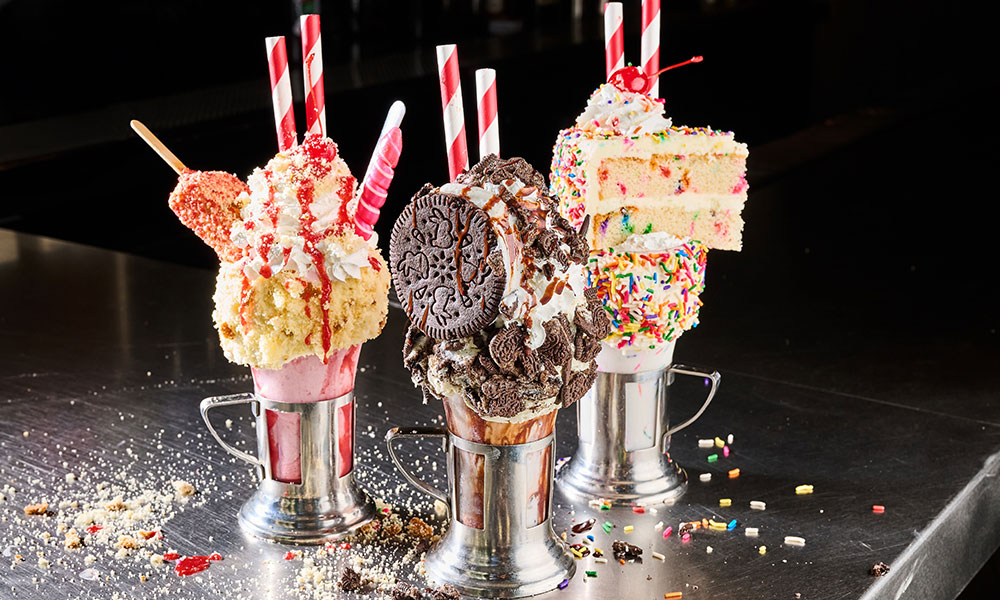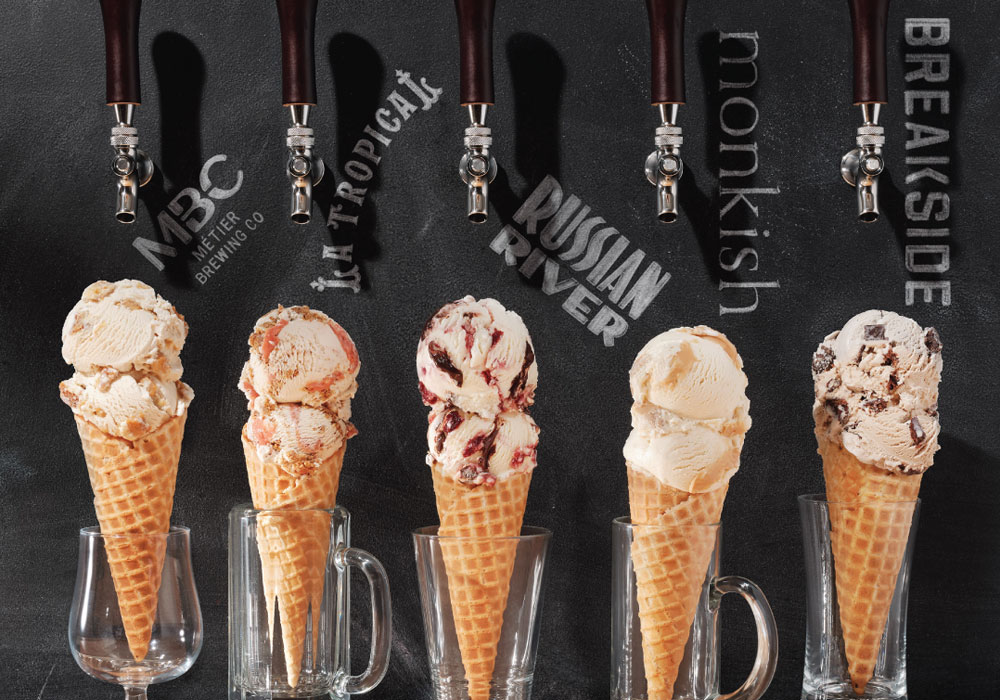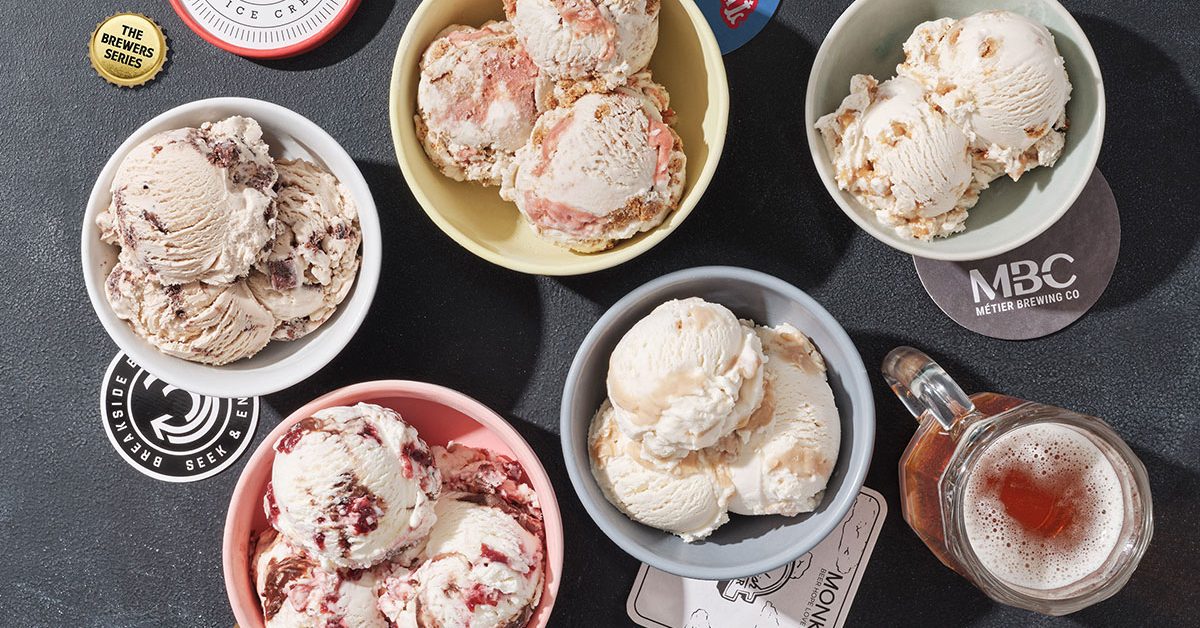In his will in 1920, Robert McCay Green, who operated a soda fountain at the Franklin Institute in Philadelphia, detailed exactly how his tombstone should be inscribed: “Originator of the Ice Cream Soda.” This soda fountain specialty, decked with a scoop of frozen dairy that perilously floated on top of a tapered glass full of soda, originated in the late 19th century.
Green staked his claim to the drink at an exhibition in 1874—150 years ago—using an array of flavored sodas. Since then, cola, root beer, birch beer, and even cream soda, which was created based on the flavor profile of vanilla ice cream, have predominantly served as the base of this fizzy, sweet sensation. At some point, beer, likely a dark ale imitating the color and carbonation of soft drinks, paved the way for an adult version of this foamy, fanciful mash-up.
Made for Each Other
Nick Contess, managing partner of Creamline, a burger, fries, and shake joint in New York City’s Chelsea Market, believes dark beers are made for ice cream. “In my head it’s the same way milk brightens coffee,” describes Contess. “Rich on rich, but it’s two distinctly different things—the richness of a stout’s strong, full flavor and the sweetness of dairy.”
The restaurant is best known for its indulgent milkshakes, but this past summer Contess brought back what he calls “a lighter option”: boozy beer floats. “A lot of people don’t drink stout in the summer,” he says, but the addition of ice cream makes them more suited to the season.
Creamline has a beer list entirely focused on New York State brews, including Montauk Wave Chaser IPA, Five Boroughs Hoppy Lager, and Torch & Crown’s Pils. Contess says that choosing a beer for a float isn’t really about the booze, it’s about the mouthfeel. Both beer and ice cream should complement each other’s creaminess. For Creamline’s floats, Contess typically uses Brooklyn’s Ebbs Stout No. 1, which pours inky black with a tawny head, and smacks of dark chocolate and light coffee roasts. Hudson Valley Brewery’s English-style milds, such as Erstwhile, make good options, too. Because these ice cream and beer pairings were working so well, Contess tried to make a stout milkshake, although it didn’t homogenize in the way he’d hoped. He instead steers people to a float as “a great introduction into heavy beers” for those who would otherwise never try one.
“We like to incorporate local craft beers [into our menus] to rep where we came from—it’s in our DNA,” says Stephen Parker, corporate executive chef of Black Tap Craft Burgers & Beer, who notes that half of the taps at the chain’s location in NYC’s SoHo are craft beers. In Vegas, 14 of the 16 lines are craft. But Parker bears in mind that not all beers are meant for dessert. “New Belgium’s Voodoo Ranger IPA is great for summer heat, and strong at 6.7 percent ABV.” Some IPAs are too high in alcohol, and bittering agents, that ruin your palate, even for ice cream.

With that in mind, Black Tap made a special aged beer with Threes Brewing in Brooklyn, fermented with cherries and reminiscent of cherry cobbler, which can be served à la mode in a shake.
“We’re not just pouring lager into a milkshake and calling it a boozy milkshake,” says Parker, and although any beer is an option for addition, their Brooklyn Blackout CRAZYSHAKE® brims with a chocolate frosted rim and mini chocolate chips topped with two chocolate brownies, whipped cream, and chocolate drizzle. A stout is the practical pour.
Thinking in reverse, milkshake IPAs seem like an obvious choice for experimentation, as they’re brewed with the same lactose (milk sugar) that ice cream is full of—adjuncts in the beer commonly include dessert-forward flavors such as vanilla, chocolate, peanut butter, and tropical fruits. “[A little] lactose takes down hoppiness, making the beers easier to drink,” says Parker. “In beer floats, ice cream acts the same way.” To prove a point, he conjures up a new CRAZYSHAKE idea on the spot; a milkshake IPA with orange juice, orange peel, and vanilla ice cream. “It would taste like a creamsicle!”
The Upside Down
Rather than adding ice cream to beer, Tyler Malek, co-founder and head of innovation at Salt & Straw, Portland, Oregon’s homegrown ice cream company, is adding beer to ice cream. For Salt & Straw’s June 2024 Pints of the Month Pack, part of Salt & Straw’s Brewers Series, Malek worked with five U.S. breweries, including Portland’s Breakside, Seattle’s Métier Brewing Company, NorCal’s Russian River, SoCal’s Monkish, and Miami’s La Tropical.
“This has been one of my passion projects for almost 14 years, since I started Salt & Straw,” says Malek, who thinks beer and ice cream have had parallel paths in craft. “Malt, hops, and water; cream, sugar, and vanilla—millions of different flavors come out of those [few] ingredients.”

Brewer Ben Edmunds started Breakside six months before Salt & Straw. “We’re three blocks away from each other; we kind of grew up together,” says Malek. They’ve brewed a Salted Caramel Stout together, based off of one of Salt & Straw most popular flavors, but for the ice cream collaboration, the two devised a custom barrel-aged chocolate stout named Shasta Taffy.
“The beer is steeped with cocoa nibs for four days, which are then dried out and folded into chocolate to create a chocolate bark,” reveals Malek. That same beer is added to the base for Breakside’s Barrel-Aged Chocolate Stout ice cream, before being swirled with chocolate bark and combined with a housemade tres leches cake.
For Malek, there are so many cool ways that beer and ice cream can interact, starting with temperature. “There are three edible antifreezes: salt, sugar, and alcohol,”says Malek, noting that they have to be at the right ratio to keep ice cream scoopable. “From a food science perspective, they all help flavors melt into your tastebuds.”
Monkish’s Space Cookies & Cream Hazy IPA was a happy accident, says Malek. “[The beer has] a creamy mouthfeel so we’re making ice cream out of it.” To amp up the hop flavors they dry hopped with Citra a few times, but the kicker was adding a little bit of grape zest to punch that last flavor note through, sandwiched between Nilla Wafer cookie butter bits.
Malek also worked with Vinnie Cilurzo from Russian River, using Supplication, a sour brown ale aged in Pinot Noir barrels with sour cherries, and didn’t try to recreate a thing. “It takes 14 months to make,” stated Malek of the coveted beer, musing, “How does this beer never touch heat?” He tried to create a frame for the beer instead, deciding to melt chocolate, pour the beer over it for a fudge-like texture, and then make a manchego beer base ice cream with vanilla, which held up to the natural lacto-fermentation of Supplication itself. Malek then took the steeped cherries from the barrel and made a marmalade, the totality acting as a beer and cheese pairing—because isn’t that what beer and ice cream inevitably is?
CraftBeer.com is fully dedicated to small and independent U.S. breweries. We are published by the Brewers Association, the not-for-profit trade group dedicated to promoting and protecting America’s small and independent craft brewers. Stories and opinions shared on CraftBeer.com do not imply endorsement by or positions taken by the Brewers Association or its members.


Share Post